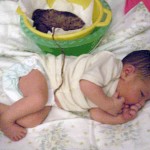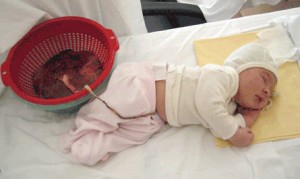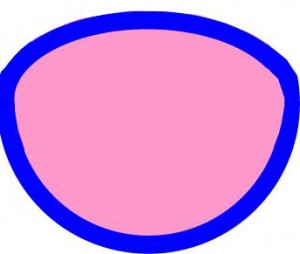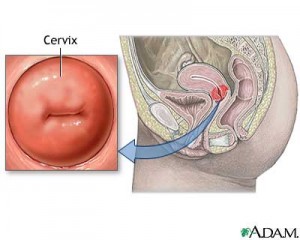Living on the east coast of the United States, NYC precisely, one will not find so many women opting for leaving the umbilical cord attached until it falls off the baby naturally. I find it fascinating, and there are parts of the U.S. as well as around the world where it is a natural custom or personal choice. Here is a story of a progressive Hospital that is ‘waking up’ to the idea that MAYBE it might actually be a good thing.
PREGNANCY – PART – Pediatrics 21/4/2009
 Lotus Birth: born naturally, In Turin
Lotus Birth: born naturally, In Turin
In Turin, the first major hospital that gave birth to a baby … with the placenta. The opinion of the expert and the testimony of mothers.
LUIGI WORLD OF THE PRINCE AND STEFANIA
Birth in water, painless childbirth, epidural anesthesia are all terms that expectant mothers feel appoint at least once. Instead of a period which speak little or no thirst and “second nature.” And it is likely that almost none has ever been asked how it wishes to happen, the second, or the final phase of childbirth, which consists in the expulsion of the placenta. But there’s something new and, although not yet become a routine practice, many parents are already experiencing the second natural birth or the placenta or the “Lotus birth. According to experts, this is the most gentle and a less traumatic way to bring a child to light. The method is very simple and is to leave the placenta attached to the baby for a few days (on average 3 or 4) until natural detachment. This gradual separation could provide the child even a small amount of placental blood, useful for the formation of the immune system. “We know that the placenta is formed from the division of the same cells that form the fetus, so baby and placenta have the same DNA. Lotus Birth is the birth that deeply respects the importance of this union’s biological child with her placenta.” This was explained by Susanna Swapana Hinnawi, Breathworker and Counselor ICC (Inner Child Codependency), referee for Italy’s Lotus Birth. “In the Lotus Birth, in fact, the umbilical cord is cut, but expects to detach itself from the navel when the child is ready for separation.” Susanna Hinnawi continued, “On average, the wait is three to four days. When the cord comes off spontaneously, the umbilicus does not need medication or special care. It is tightly closed and healed, often times less than when the umbilical cord is severed.”
placenta have the same DNA. Lotus Birth is the birth that deeply respects the importance of this union’s biological child with her placenta.” This was explained by Susanna Swapana Hinnawi, Breathworker and Counselor ICC (Inner Child Codependency), referee for Italy’s Lotus Birth. “In the Lotus Birth, in fact, the umbilical cord is cut, but expects to detach itself from the navel when the child is ready for separation.” Susanna Hinnawi continued, “On average, the wait is three to four days. When the cord comes off spontaneously, the umbilicus does not need medication or special care. It is tightly closed and healed, often times less than when the umbilical cord is severed.”
We asked Susanna…
What are the benefits of this mode of delivery?
“It’s hard to have to summarize in a few words … speaking from a physiological point of view, the connection to the placenta causes the baby to receive all the rich oxygenated blood, important for the proper development of organs still immature at this delicate stage of adjustment. When the cord is cut in the opening minutes, the placenta remains to be 30% to 50% of the blood that should go to the baby! Another aspect to consider is that of breathing, being under the pulmonary system a perfect autonomy, continues to be from two sources in parallel: the placenta and lungs. Then, if the cord is cut, we avoid separating the child from his birth mother, a union which must absolutely be preserved! But what struck me most is the emotional and psychological. Training for staff believe that birth is the cornerstone on which to build their lives. Born without trauma, in a respectful and friendly atmosphere, is definitely a good start on which it is easier to develop aspects of character for completeness and integrity. This is keeping together the biological unit formed by the baby and placenta, avoiding any kind of injury, both physical and emotional. If we are not “wounded” we are at peace. There are no scientific studies demonstrating the benefits of Lotus Birth, but from what I started to notice, children born without cutting the cord has shown generally a strong immune system, a pronounced tendency to socialization and autonomy. Moreover, there are many studies showing how important it is to delay cutting the cord until the end of the pulse. Well, the Lotus Birth is merely an extension of this delay that is safe, but, brings additional benefits.”
 So the Lothus Birth should not be seen as a particular technique to be used during childbirth, but a conscious and responsible choice that guarantees health and wealth to the unborn. “I would point out that this mode must be understood as a piece in the mosaic that makes up a responsible choice of birth” says Suanna Hinnawi. A birth in which the woman picks up herself, is in contact with your body, with its emotions and fears, has chosen to be with his child, the only protagonist. An event that should not be delegated to anyone except her ability to procreate mammal: so from spectator to player, from lamb to lioness! After this introduction, the Lotus Birth may also occur after a cesarean section, in all those conditions in which the placenta is healthy and there are no other impediments. Indeed, after a caesarean, as well as a premature baby, it would be more desirable because it provides an excellent support to the respiratory system that in both cases is greater compromise.”
So the Lothus Birth should not be seen as a particular technique to be used during childbirth, but a conscious and responsible choice that guarantees health and wealth to the unborn. “I would point out that this mode must be understood as a piece in the mosaic that makes up a responsible choice of birth” says Suanna Hinnawi. A birth in which the woman picks up herself, is in contact with your body, with its emotions and fears, has chosen to be with his child, the only protagonist. An event that should not be delegated to anyone except her ability to procreate mammal: so from spectator to player, from lamb to lioness! After this introduction, the Lotus Birth may also occur after a cesarean section, in all those conditions in which the placenta is healthy and there are no other impediments. Indeed, after a caesarean, as well as a premature baby, it would be more desirable because it provides an excellent support to the respiratory system that in both cases is greater compromise.”
We understand that in Italy this is a technique almost unknown. Are there other countries where it is practiced more often?
“In Italy the Lotus Birth was introduced in 2004, when it was translated and published in the book in Australia: Lotus Birth: the Integral, Born with the Placenta. ” In recent years, our association has been working to publicize this way of coming into the world. It maybe a little unusual, but certainly natural, and above all without contraindications. Children are born in our homes, maternity homes and even in those hospitals where doctors “enlightened” or maybe even just curious, have allowed to happen. In Australia and Canada this has been a very common mode since the end of the ’70s.”
Lotus Birth may be required in an Italian hospital?
“The hospitals have their protocol from which they rarely waiver. However, as I said above, some doctors are particularly sensitive, especially in structures of the province, and have accepted the Lotus Birth into the official hospital protocol. The paradox is that although there are no scientific studies that demonstrate the need to cut the umbilical cord, the failure to cut it often needs to be proven scientifically! I welcome the availability of wanting to start a search. Unfortunately, these funds fall outside our capabilities.”
particularly sensitive, especially in structures of the province, and have accepted the Lotus Birth into the official hospital protocol. The paradox is that although there are no scientific studies that demonstrate the need to cut the umbilical cord, the failure to cut it often needs to be proven scientifically! I welcome the availability of wanting to start a search. Unfortunately, these funds fall outside our capabilities.”
It is true that one of the first hospitals to test the Lotus Birth technique was the Sant’Anna di Torino?
“Not really. The Sant’Anna di Torino was perhaps the largest hospital in which both happened. Moreover, thanks to a very tenacious and determined mother, the first Lotus Birth was in 2006 in a hospital in the province of Mantua. Despite initial resistance, this is now a public hospital that can conduct Lotus Births. We know this from direct experience with Eusebius Prabhat and Monica Farinella, parents of small Deva was born December 16, 2008 right in the Sant’Anna di Torino.
Before you tried this new experience, did you have any fear or doubt?
 “The first time we heard about the Lotus Birth was during the course of our pre-natal with eldest Munay. Midwives have referred to this technique, namely the ability to not sever the umbilical cord and leaving the child attached to the placenta, until natural detachment. For us it was immediately clear that the party had practiced this technique, and bought and read the book. I had no doubt or fear in wanting to run the integral part. ”
“The first time we heard about the Lotus Birth was during the course of our pre-natal with eldest Munay. Midwives have referred to this technique, namely the ability to not sever the umbilical cord and leaving the child attached to the placenta, until natural detachment. For us it was immediately clear that the party had practiced this technique, and bought and read the book. I had no doubt or fear in wanting to run the integral part. ”
What sensations did you feel with the Lotus Birth?
“Around the baby was a feeling of sacredness, all emotions were amplified. The strongest feeling was to assist the mystery of creation in a way that reflected and respected the time of life and nature. Since in last 100 years, the event of birth has been completely “industrialized” to the paradox of planned caesarean. The two cases are differentiated by Lotus in the continuation of the days when the cord was still attached to the placenta, Munay let go of her placenta between the 6th and 7th days, Deva between the 3rd and 4th. ”
Was there skepticism on the part of the Santa’Anna Hospital staff and doctors?
 “Rather than skepticism, we would say ostracism. New ideas can bring fear. Our civilization is founded on dogmas at all levels. Suffice it to say that for hospital protocol, the placenta is considered a refusal and not an organ, where it is not sold (but that’s another story). I’m amazed that the medical director of a company such as the Santa’ Anna Hospital responded to my question by talking in terms of ownership of the placenta. You can not deny the biological origin of the placenta. As a result of insemination sperm / ovum has not been able to answer, the answer is that the logic can shatter any dogma, then we realize the opening of minds and accept new truths. Eventually, after more than two hours of discussion, we came out tonight with girls and placenta, and a historic declaration by a hospital: a certificate stating that a health worker can not sever the umbilical cord without parental consent. This was a revolutionary step for natural childbirth. Thanks S. Anna Hospital.
“Rather than skepticism, we would say ostracism. New ideas can bring fear. Our civilization is founded on dogmas at all levels. Suffice it to say that for hospital protocol, the placenta is considered a refusal and not an organ, where it is not sold (but that’s another story). I’m amazed that the medical director of a company such as the Santa’ Anna Hospital responded to my question by talking in terms of ownership of the placenta. You can not deny the biological origin of the placenta. As a result of insemination sperm / ovum has not been able to answer, the answer is that the logic can shatter any dogma, then we realize the opening of minds and accept new truths. Eventually, after more than two hours of discussion, we came out tonight with girls and placenta, and a historic declaration by a hospital: a certificate stating that a health worker can not sever the umbilical cord without parental consent. This was a revolutionary step for natural childbirth. Thanks S. Anna Hospital.
Did the birth occur without the aid of oxytocin, monitoring, epidural, episiotomy, antibiotics, the delivery room couch, pushed manuals, etc.. due to the Lotus Birth choice?
“The mother and baby did not have medical interventions by choice. Because of the media, pressure from the medical establishment regarding time limits regarding getting the baby born safely, it seems, women today no longer trust their bodies and baby’s ability to birth without all these interventions and interruptions. For generations, childbirth has been portrayed as an agonizing, suffering experience. In truth the best thing would be for everyone to trust the rhythms of nature and the abilities of woman to do this without and ‘operation’ or medical intervention. It is helpful for women and medical caregivers to properly prepare (mentally and physically) the potential for the woman to have a natural childbirth without intervention. If the woman and child are supported by the medicate caregivers to be given time to communicate, feel each other and have a close connection, the rest takes place naturally.”
 For More Information Check Out:
For More Information Check Out:
Wikipedia- Lotus Birth – http://en.wikipedia.org/wiki/Lotus_birth
Article By Sarah J. Buckley, MD – Lotus birth – a Ritual for our Times
http://www.sarahbuckley.com/lotus-birth-a-ritual-for-our-times/
Journal By Jenny Hatchs on Lotus Birth – A Lotus Birth, Jenny Hatchs pregnancy journal (Kindle Edition-2003) – http://www.amazon.com/Lotus-Hatchs-pregnancy-journal-ebook/dp/B002KAOAFE/ref=sr_1_4?ie=UTF8&qid=1376414304&sr=8-4&keywords=Lotus+birth
Article By Artemiss Keyhani – Forceps + Lotus Birth http://www.mybirth.com.au/26-10-2009/forceps-lotus-birth-—%C2%A0artemiss-keyhani.html
Lotus Born Birth Bags – By Etsy – http://www.etsy.com/shop/LotusBorn
DVD –Lotus Birth: The Water Birth of the Malcolm Twins – http://www.lotusbirth.net/index.php/the-dvd
Review of DVD – Lotus Birth: The Water Birth of Malcolm Twins By Binnie A. Dansby – http://birthpsychology.com/content/lotus-birthlotus-birth-water-birth-malcolm-twins
Book – on Lotus Birth By Shivam Rachana – Lotus Birth
http://www.lotusbirth.net/index.php/the-book
Blog and description of Lotus Birth By Born To Bloom –
http://www.lotusfertility.com/Lotus_Birth_Q/Lotus_Birth_QA.html
Blog on Lotus Birth By Birth Well- http://www.birthwell.com.au/lotus_birth.html
Blog on Lotus Birth By Hawai’i Holistic Midwifery –
http://www.unfoldinglotus.com/lotus-birth.html
Youtube link to “Lotus Birth” Videos – http://www.youtube.com/results?search_query=Lotus+Birth&oq=Lotus+Birth&gs_l=youtube.3..0l2.10465.15378.0.15691.21.16.4.1.1.0.146.1382.10j6.16.0…0.0…1ac.1.11.youtube.RdJE9LsCu68


 The argument for delayed cord clamping is often used as a springboard for those who believe in lotusbirthing, a more extreme version of delayed cord clamping.
The argument for delayed cord clamping is often used as a springboard for those who believe in lotusbirthing, a more extreme version of delayed cord clamping.
















 “I think it’s a good and empowering thing for a woman to check her own cervix for dilation. This is not rocket science, and you hardly need a medical degree or years of training to do it. Your vagina is a lot like your nose- other people may do harm if they put fingers or instruments up there but you have a greater sensitivity and will not do yourself any harm.
“I think it’s a good and empowering thing for a woman to check her own cervix for dilation. This is not rocket science, and you hardly need a medical degree or years of training to do it. Your vagina is a lot like your nose- other people may do harm if they put fingers or instruments up there but you have a greater sensitivity and will not do yourself any harm. “The best way to do it when hugely pregnant is to sit on the toilet with one foot on the floor and one up on the seat of the toilet. Put two fingers in and go back towards your bum. The cervix in a pregnant woman feels like your lips puckered up into a kiss. On a non-pregnant woman it feels like the end of your nose. When it is dilating, one finger slips into the middle of the cervix easily (just like you could slide your finger into your mouth easily if you are puckered up for a kiss). As the dilation progresses the inside of that hole becomes more like a taught elastic band and by 5 cms dilated (5 fingerwidths) it is a perfect rubbery circle like one of those Mason jar rings that you use for canning, and about that thick.”
“The best way to do it when hugely pregnant is to sit on the toilet with one foot on the floor and one up on the seat of the toilet. Put two fingers in and go back towards your bum. The cervix in a pregnant woman feels like your lips puckered up into a kiss. On a non-pregnant woman it feels like the end of your nose. When it is dilating, one finger slips into the middle of the cervix easily (just like you could slide your finger into your mouth easily if you are puckered up for a kiss). As the dilation progresses the inside of that hole becomes more like a taught elastic band and by 5 cms dilated (5 fingerwidths) it is a perfect rubbery circle like one of those Mason jar rings that you use for canning, and about that thick.”

